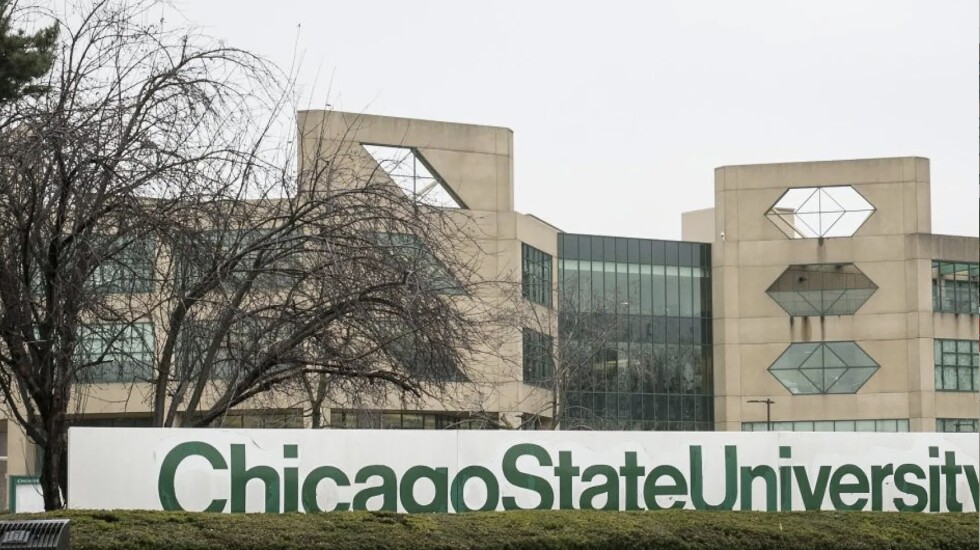
Faculty members at Illinois’ only predominantly Black public university could go on strike as early as April 3.
University Professionals of Illinois Local 4100, representing 160 professors, lecturers, academic support professionals and technical support professionals at Chicago State University, filed an intent to strike notice with the state’s education labor relations board on Thursday, a bureaucratic checkbox required before union members can walk out.
“The membership guides what we do, and they wanted this notice to move forward because they see that the administration is not taking us seriously,” said Valerie Goss, chemistry professor and faculty union president at Chicago State.
Earlier this month, after nine months of stalled negotiations over a new labor agreement, 98% of voting faculty members authorized a strike. Two bargaining sessions are scheduled next week, on March 27 and March 30.
In a written statement, Chicago State administrators said they are committed to negotiating a fair contract.
“Chicago State University greatly values the contributions of our faculty who are core to providing transformational education to the students at CSU,” the statement said. “CSU has offered an economic proposal to UPI Local 4100 and is awaiting a response.”
Goss said administrators have not moved close enough to union requests on compensation and workload.
“In many cases we’re fighting to get across the finish line, to do what we need to do to be available and ready and fresh for our students, and it just seems out of balance with what we see at the other institutions,” Goss said.
According to the most recent data available from the Illinois Board of Higher Education, Chicago State University faculty are some of the lowest paid professors in the state.
“And we’re serving students that have some of the greatest needs,” Goss said. “When you talk about faculty that get down and teach, meet students where they are and bring them up — that’s us.”
Located on the Far South Side, Chicago State serves 2,366 undergraduate and graduate students, according to federal data. Nearly 7 out of 10 are Black.
Goss said she knows how well the school serves these students because she was once a student there herself. She grew up nearby in Roseland and graduated with a bachelor’s degree in chemistry.
“I would not have had an opportunity to go even down to UIC,” she said. “I was married earlier and I had children and I worked. This would have been my only shot to have a chance for college.”
Federal data show that half of the students at Chicago State University are 25 or older. Forty-five percent receive Pell Grants reserved for students with the most financial need.
“These regional institutions play a very important role,” said Robert Bruno, a professor of labor relations at University of Illinois Urbana-Champaign. “And when they’re underfunded, or when the employer isn’t properly valuing the work of the educators inside their system, they’re also dismissing and having a negative impact on the student body that’s going to attend Chicago State.”
Bruno said he isn’t surprised that faculty unions at Chicago State and other institutions in the state are inching toward or have already engaged in strikes.
Faculty at Eastern Illinois University just announced they are filing an intent to strike. UIC went on strike for five days in January to secure a contract.
“It speaks to the lack of support for those institutions, which puts pressure of course on the employer,” Bruno said. “But it also cascades down to the people that work there … The staff isn’t going to grow, enrollment hasn’t grown, fallen state support hasn’t kept up to meet what the needs are. So on one hand, the employer is going to feel like its resources aren’t ample enough. But the workers are going to feel the increased burden that’s placed.”
Although state funding for higher education has been on the up since Gov. J.B. Pritzker took office, levels are still below what they were two decades ago. That puts an additional financial burden on smaller universities that rely more heavily on public funding as opposed to tuition revenue.
“The state has an obligation to address racial and economic inequities,” Bruno said. “And one of the best ways to do it is to fund colleges like Chicago State.”
Lisa Philip covers higher education for WBEZ, in partnership with Open Campus.




!["[T]he First and Fifth Amendments Require ICE to Provide Information About the Whereabouts of a Detained Person"](https://images.inkl.com/s3/publisher/cover/212/reason-cover.png?w=600)


